 |
|
5. Sturm in the Caillettewald
The 5. Sturm history area used with the kind permission of the Kaiser's Cross website,
located at www.kaiserscross.com. Please visit this outstanding website!
Right: Pionier Adolf Breuer of the 4. Sturm-Komp. who was decorated with the EK2 by the Kaiser on the 14th of August 1916. His Iron Cross document can be seen below. To see more of him, go HERE
The 4. Sturm-Kompagnie had fought in the Caillette-Wald in the first days of June, then finished the month assisting the Bavarians in the Attack on Fleury and in the Chapitre-Wald. July saw more heavy fighting and the Company took part in assaults on the “Kalte Erde” (Froideterre) in the last days of July and beginning of August. It was the 4th Company that was chosen to demonstrate the assault tactics and use of hand grenades to the Kaiser and his entourage. The demonstration was to be as realistic as possible, so much so that three Pioneers from the company were killed in the preparations on the 10th of August. Author and Officer Walter Bloem accompanied the Kaiser and wrote… “It is a day for the young. Even the commander gave off a youthful aura. All subordinates were young, the men themselves almost children or at least youthful, between 19-21 years of age. The modern “Sturmangriff” requires hard bodies and rock steady nerves, best found in the men of this age…. In this school for assault troops “offensive close combat” is taught. The men are then only to be used for the “Sturmangriff”. The nerve wracking trench occupation, bombardments and beating off enemy attacks was not their lot. They come, they see, they conquer… then leave!” The equipment is reduced to just what they need for their task. The young “Sturmer” are armed to the teeth. A Pioneer spade with a short handle, a bayonet, rifle on its strap. Around their necks are sandbags, filled with stick and egg grenades….” After the Demonstration it was time to reward the men who had been in battle in the preceding two months “And now, for those who have taken part in battle, comes the honor earned with blood. The Iron Cross. The Kaiser’s satisfaction is evident, conveyed in the conversations and jokes during the ceremony. An event that will remain in the memory of the participants” 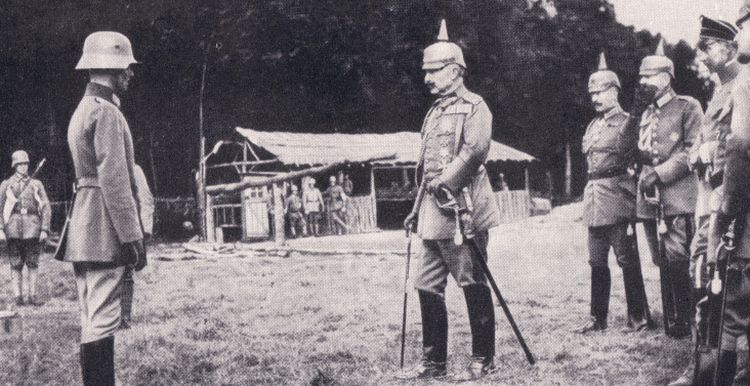 Above: The Kaiser and Hauptmann Rohr The 4. Sturm-Kompagnie had been “blooded” in the attack on the Caillette forest. It was a textbook operation, fast, aggressive and all over before the command knew what was happening. Previous efforts having failed the attack was carried out by the 2nd Bavarian and 7th Reserve Division supported by elements of the Sturm-Bataillon Nr. 5 and the Garde Flamethrowers under Leutnant Theune.
A memo from a French officer of the 5eme Regiment d’Infanterie describes the confusion and the use of grenades by the attacking troops… “A terrible bombardment hit the positions, wounding about half the men. Machine Guns were put out of action, rifles and hand grenades buried, what was left of the trenches collapsed. At 7:00am the enemy attacked the 24e R.I. then the Battalion Mercier (of the 5e R.I.). The enemy enveloped them and advanced on Company Demougin. Battalion Bad on the left was alerted. Company Seutet had been in reserve and arrived to support Mercier and Demougin. Company Blery attacked at 07:30am. Letac, who was wounded, announced the enemy are advancing on our front. There is shooting all along the line. The two companies were outflanked. Company Ordini attacked, the commander right away wounded. At 08:15am the fighting is at the Battalion HQ. Rifles against German machine guns and hand grenades. The barricades had been destroyed by the barrage, and the enemy tossed hand grenades into the command post. There are 50 wounded men inside, screaming. An enemy machine gun opened up firing directly into the entrance. Suddenly the enemy was inside. The few defenders were not in any position to continue the fight. At 08:45 the command post fell with 6 officers and 130 other ranks captured.” A composite description of the attack on the Caillette-Wald taken from various German sources follows: Paraphrased from the Unit History of the Sturm-Bataillon Nr. 5 (Rohr) Towards the end of May one of the prime objectives of the “Angriffsgruppe Ost” at Verdun was to finally push the French out of the Caillette-Wald (Forest) which had become a salient in the middle of the German line. Numerous attacks had been launched, from the Vaux-Kreuz heights and from the Hardaumont, all which had failed to clear the forest. The edge of the ravine was under constant accurate French machinegun fire. Messengers, ration carriers or anyone moving from the front to the rear suffered under their fire. Enemy Artillery fire combed the area to the rear. In April – May five attacks were carried out by the Germans, the failures had a negative effect on the moral of the German troops. Replacement divisions arriving in May 1916 were to continue the efforts to capture the forest. Before taking their place in the line they were trained by the men of the Sturm-Bataillon Rohr, learning the new doctrines developed by the unit. 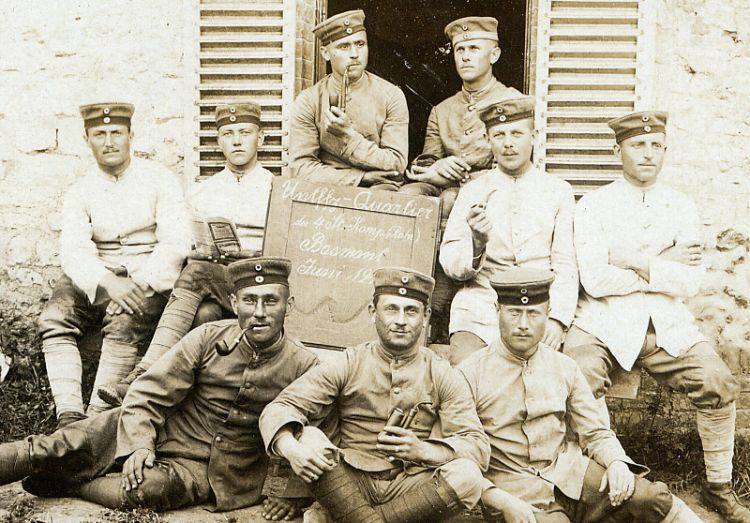 Above: The Unteroffizier of the 4. Sturm Kp. of the Sturmbataillon Nr. 5 (Rohr) Two attacks were on the drawing board, an attack on the Caillette-Wald and an attack on the Waben-Graben. These attacks were to be accompanied by the newly created 4th and 3rd Companies of the S.B. Rohr. Although the men had combat experience, it was to be their first combat as a unit. On the 1st of June the 4th Company (Leutnant Fitz) took part in the attack on the Caillette forest, attached to units of the 7th Reserve Division. On the 8th of June the 3rd Company attacked the Wabengraben (west of Douaumont) while attached to the 1st Bavarian Division. During the attack on the Caillette-wald the 4th Company was split into Sturm-Trupp and were attached to the advancing infantry, jumping in when the going was difficult. It was a text book operation, the German artillery had boxed in the sector and the final objective was rapidly taken. 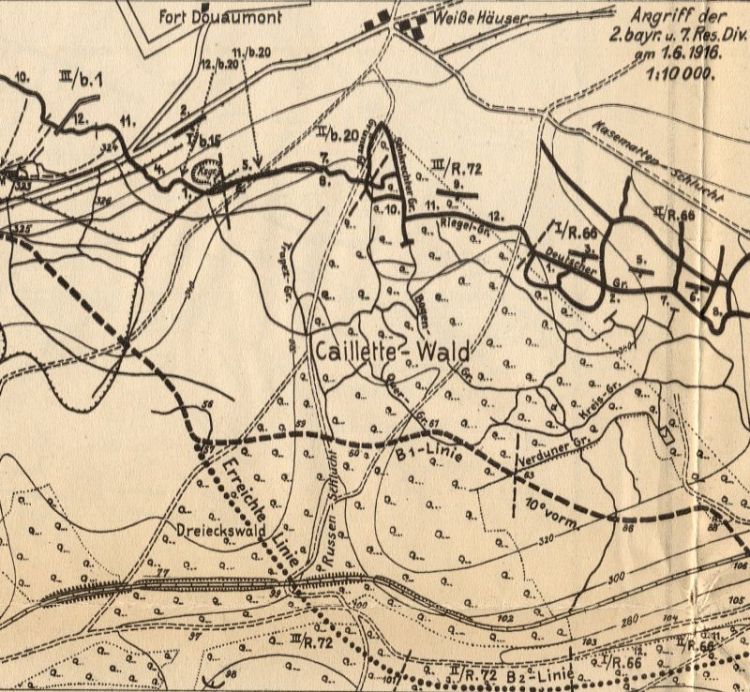 Above: A map showing the attack in the Caillette-Wald in June 1916. The Germans attacked from the top of the map to the bottom. Paraphrased from the “Reichsarchive” While the Bavarian 1. A.K. was attacking on the Thiaumont Heights at the end of May, the Divisions on their left flank were getting ready for a final assault to finally take control of the Caillettewald. A surprise attack had been planned by the 6th Division with 10 flame throwers and Sturmtruppen attacking the French positions but events had overtaken the planning and when the 7. R.D. and 1. I.D. (under the X. R.K.) took over the sector the element of surprise had already been lost. The objective of the X. R.K. was to clear the Caillette Forest of French troops and continue through the Vaux valley to the slopes that rose up to Fort Vaux. The attack took place on the 1st of June and it turned out to be a day, one of few at Verdun, where everything fell into place for the Germans. Oberleutnants Theune and his 10. Komp. of the Garde Reserve Pionier Regiment (Flamethrowers) had been planning a flamethrower attack but the heavy artillery fire had nullified any element of surprise. The German fire had been accurate and devastating, but it had provoked a French counter barrage that made it extremely difficult to bring up the assault troops who were supposed to carry out the attack.
Leutnant Theune’s men were supposed to spearhead the attack but five of the ten flamethrowers had been destroyed by artillery fire. These ten FW were supposed to cover the entire front of the attacking 7. R.D. but due to the losses the remaining five were moved to the 66. R.I.R. zone on the left flank where concrete infantry bunkers could be found in the Vaux valley. They would prove useful to “smoke out” the occupants. Just before the start of the attack another setback struck. In the Kasematten Schlucht the assault troops had been subjected to French artillery in the hours leading up to the attack. They were then suddenly hit by salvos of German artillery fire which fell too short. It seemed unlikely that the infantry would make it to their jump off points on time so Theune, whose men lay in advanced positions and had been spared much of the barrage, decided to give the signal to attack. He had confidence in his troops and their weapon. At 9:30 am the burning oil snaked towards the French trenches where the tightly bunched defenders watched helplessly as it approached. The shocked troops surrendered with barely a shot fired. Their positions had been pounded and bludgeoned by artillery, their trenches had collapsed… the liquid fire was enough to convince them that their position was hopeless. The II./66. R.I.R. (Major Piper) was on the left flank, the I./66. R.I.R. (Hauptmann d.L. Dettmer) on the right. Their troops rushed through the enemy defensive positions, met with barely and enemy resistance. Even the Infantry Bunkers ( I-Werk/Infanterie Werk) which had withstood the heaviest shells were forced to surrender when taken under fire by the flamethrowers. The 8./66. R.I.R. on the left wing was taking fire from the Fumin-Wald on its left flank. In spite of this they pushed forward to the railway lines. The company commander signaled he would have been able to take the heights in the Chapitre-Wald if their own artillery had not hindered their advance. In front of the 72. R.I.R. the artillery had prepared the way. The artillery had stunned the defenders and most surrendered right away. Isolated resistance was dealt with rapidly. Lt. d.Res Müller of the 11. Kp. was first into the enemy trench. He captured a Machine Gun and tossed it out of the trench. Other French machine guns opened up but were rapidly silenced. The Germans reached their first objectives then paused while the German artillery shifted to the railway embankment. A second push started and the French 24e R.I. crumbled under the weight of the attack. The regimental commander and hundreds of prisoners sheltering in bunkers along the railway embankment were taken prisoner. A German defensive line was set up about 200m to the South of the Railway embankment, at the edge of the Caillette forest. Patrols sent out found no enemy troops; these would arrive for a counter attack the next day. By then the men of S.B. Rohr had been pulled from the line. 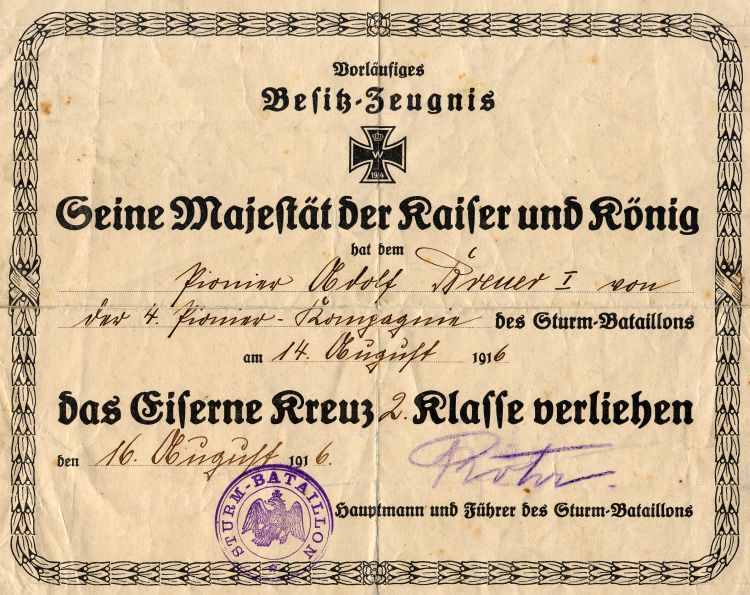 Above: The Iron Cross 2nd Class document for the award of the Iron Cross awarded by the Kaiser to the then Pionier Adolf Breuer on the 14th of August 1916 Above: The Iron Cross 2nd Class document for the award of the Iron Cross awarded by the Kaiser to the then Pionier Adolf Breuer on the 14th of August 1916 |
|

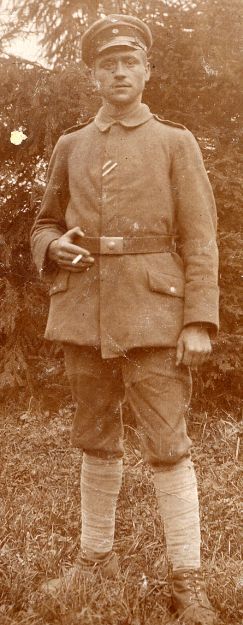 On the 14th of August 1916 the Kaiser visited Doncourt to get to know the men of the Hauptmann Rohr’s Sturm-Bataillon Nr. 5.
On the 14th of August 1916 the Kaiser visited Doncourt to get to know the men of the Hauptmann Rohr’s Sturm-Bataillon Nr. 5.
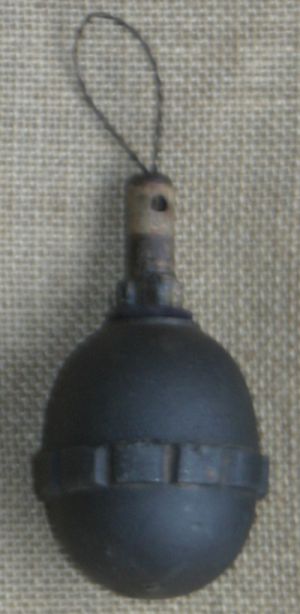 <<< A German Eierhandgrenate (egg hand grenade) as used in the assaults of the S.B. Rohr
<<< A German Eierhandgrenate (egg hand grenade) as used in the assaults of the S.B. Rohr
 <<<A German Stiehlhandgrenate (Stick Grenade). This particular hand grenade was found on the Verdun battlefield almost 90 years after the battle. A fantastic piece of luck, it was preserved in the mud.
<<<A German Stiehlhandgrenate (Stick Grenade). This particular hand grenade was found on the Verdun battlefield almost 90 years after the battle. A fantastic piece of luck, it was preserved in the mud.